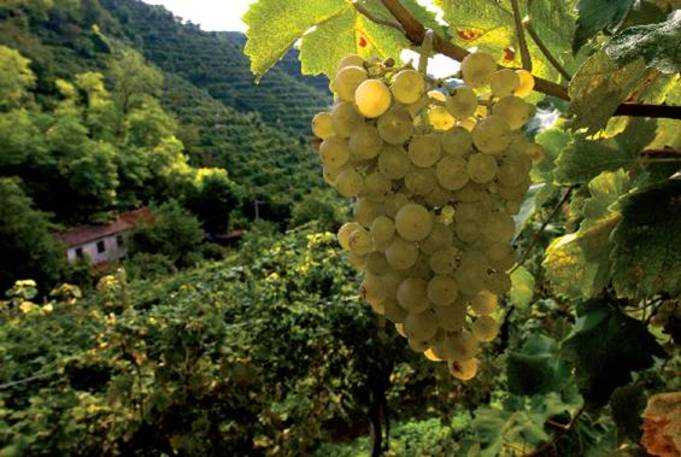


“Prosecco is now DOCG”, read the headline, but what does that really mean for Italy’s largest selling sparkling wine? Now prosecco has the same “G” for guaranteed as Brunello has, and we know only too well what is going on in Montalcino! While I was still thinking of all the questions I had about Prosecco and the new regulations, Mionetto invited me to lunch at Union Square Café. I jumped at the chance to taste their Prosecco and have my questions answered.
Our host was Enore Ceola, the marketing director for Mionetto. This company is one of the leading producers of Prosecco and has been in business for more than 120 years. It is still a privately held and family-run business. I had met Mr. Ceola before and not only is he very knowledgeable about Prosecco, but he also gives straight answers to even the most difficult questions.
As we sipped the Prosecco, Mr. Ceola told us that the Romans brought this grape to the Veneto and called it Pucino. He explained that the Conegliano/Valdobbiadene zone, the historical area around these two towns, would now become DOCG. The zones that were IGT would now become DOC, and the rest IGT. Only the producers in the DOC and DOCG zones will be allowed to call their wine Prosecco, while those in the IGT zone will have to call it Glera. The term Prosecco will be used to identify the region that the wine comes from and the grape will be Glera.
Bringing more production zones under the DOC/DOCG regulations should make the quality of Prosecco improve, Mr. Ceola said. Many producers in the IGT zones have not followed traditional methods leading to an inferior product that confused the consumer. The new laws will protect the producers who have worked honestly and respectfully following the traditions of the terroir, and the winemaking heritage that comes from this wine area.

Mr. Ceola also said that with the new law, a producer cannot make a “Rose Prosecco” (which I always saw as a contradiction in terms) nor have the words Prosecco Blend on the label.
Prosecco is now produced all over the world, even in Brazil. Mr.Ceola hopes that the new laws would preserve Prosecco’s identify and integrity and that the new regulations will help people to understand that true Prosecco only comes from the Veneto.
Mr. Ceola believes that there is a difference in the Prosecco produced in Valobbiadene and Conegliano. Valdobbiadene produces lighter, more elegant wines with a mineral character. It gets more sun as it faces southwest and the soil is chalk and limestone so the wines must go deeper to get water. This area makes the best spumante
In Conegliano the soil is clay and much heavier which gives the wine more body and makes them more rustic. It is closer to the Dolomites in the north and makes better firzzante wines.
Mr Ceola said that the price of Prosecco will go up because of the lower yields allowed by the new laws. But this price increase would be only temporary because the producers will plant more vines and eventually the prices would come down again. It is interesting to note that 2009 has seen a dramatic fall of the price of grapes in Italy. Prices have decreased between 10% & 50%. The only variety that has not dropped in price is the Prosecco grape from the new DOCG, Conegliand/Valdobbiadene!
.His main concern was a very interesting one. He feels that if the yields in the new regulations are too low, the producers may make a wine that is too concentrated, with higher alcohol content. This wine may be even more elegant but would not taste like traditional Prosecco as we know it.
I was very impressed with all of the Mionetto wines that I tasted but the one that I was most interested in was the Mionetto Prosecco--Certified Organic made from 100% Prosecco grapes. It has been Certified Organic by Bioagricert SRL: its packaging: bottle, label, cork, foil, necker and shipper are all recyclable. The bottle is even made of recyclable glass. The color of the wine was a darker yellow than other Prosecco and was very elegant with undretones of citrus fruits and apples, a hint of toast and good acidity, but it still tasted like traditional Prosecco. He said that only the very best grapes were used for this wine and it did not undergo the last filtration process. This would account for its deeper color and richer aromas and flavors. The price is about $16 a bottle and like all Prosecco it should be consumed within three months of purchase.
For more on Prosecco see my article: Two Italian Classics – Prosecco and Panettone -July 20, 2008
----
Michele and I will be teaching at De Gustibus Cooking School at Macy,s on
Thursday Dec 3, 2009 www.degustibusnyc.com [2] [email protected] [3]
212-239-1652 Hope to see you there!
Source URL: http://newsite.iitaly.org/magazine/dining-in-out/articles-reviews/article/new-docdocg-designations-prosecco
Links
[1] http://newsite.iitaly.org/files/11034prosecco-grapes1253292114jpg
[2] http://www.degustibusnyc.com
[3] mailto:[email protected]